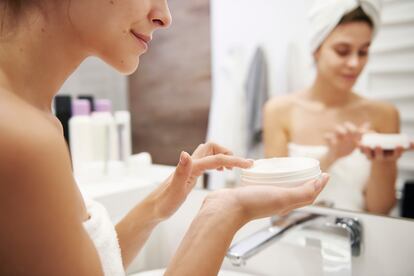‘Creams don’t work miracles’: Four dermatologists explain their skincare tricks
Experts warn that using too many products in your facial routine can be counterproductive

To turn a cleansing cream into an exfoliant, actress Ester Expósito adds coffee grounds, according to what she says in a video published on TikTok. “This is a mistake. The particles are too large and rough and can cause small wounds on the skin,” warns dermatologist Gadea Braceras Rincón. On TikTok, there are more than 18.4 million posts with the hashtag #skincare and more than 44,000 with #facialroutine. Many users with no training in dermatology give advice that is not suitable for all skin types and can be harmful. EL PAÍS has contacted four dermatologists to find out their tricks and the most common mistakes people make in their skincare routine.
Alexandre Docampo
Dermatologist Alexandre Docampo opts for a “minimalist” facial routine. “I focus on steps that actually have scientific evidence to improve skin,” he says. He washes his face with a gentle scrub in the morning and at night. In the mornings, he applies SPF 50 sun protection, and in the evenings he uses a 1% retinol preparation. It is a routine that could be extrapolated to other people, except if you suffer from a skin disease, according to the expert. “The 1% retinol I use is very powerful. For unaccustomed skin, I recommend starting with lower concentrations like 0.2% and gradually increasing it,” he adds.
Docampo recommends protecting yourself from the sun to prevent photoaging and avoid skin cancer, in addition to not applying excess products: “It is important to be aware that creams do not work miracles. Guided by advertising, many people end up using dozens of steps in their facial care routine, which is not only ineffective, but can be counterproductive,” he says. He insists that many creams are sold “without any active ingredient that is clearly beneficial.” Added to this is that applying an excess of products to the skin “can produce interactions between the product and the Demodex mite, which is responsible for many cases of skin sensitivity, causing it to proliferate.”
Gadea Braceras Rincón
The basis of any cosmetic routine rests on three pillars, according to Braceras: cleansing, transformation, and photoprotection. In the morning, the dermatologist performs a facial cleansing and applies a serum or cream with antioxidants, such as vitamin C or niacinamide, to “prevent oxidative damage.” Finally, use a broad-spectrum SPF 50 sunscreen. At night, you usually do a double cleanse. First use a product in oil or micellar water, followed by a cleansing gel. Then, alternate different transforming active ingredients, such as retinoids or hydroxy acids.
Your routine should not always be the same. It adapts it according to the needs of your skin at all times. It takes into account if you break out in acne or rosacea, if you feel excessively dry, or if you have a special event. “Since everyone’s skin is unique, it is essential to personalize the routine and adapt it to your specific needs,” says the expert, who insists that this routine would be different for adolescent skin.
One of the most common mistakes people make is not applying sunscreen daily: “Some people believe that tanning gradually and without burning is not harmful, but this is completely false. It is important to understand that tanning is a defense mechanism for the skin and that there is no such thing as a healthy tan,” says the dermatologist. She also advises against imitating social media challenges and copying facial routines from influencers or other people.
Natalia Jimenez
Dermatologist Natalia Jiménez with the Pedro Jaén Group, claims to follow a “simple” facial routine: “I tend to use few products, but I select them very carefully and I take into account the concentration of their active ingredients.” She always cleanses her skin in the morning and at night with a liquid soap: “I usually like those that contain glycolic acid.” Some mornings, she uses a particle exfoliant after cleansing “to brighten up the skin.” Next, she uses a vitamin C serum and a broad-spectrum sunscreen. After cleansing the skin again at night, she uses a cream that contains pure retinol at a concentration of 0.5%.
“I consider that it is not a routine that works for everyone, because everyone’s skin has needs that can vary throughout the year or due to different hormonal and environmental factors,” she says. She herself modifies her routine in summer: “I usually use retinol on fewer days of the week and I complement it with a cream with hyaluronic acid on the nights when I do use it.” The expert advises talking to a dermatologist to find out what your skin needs and “save time, money, and possible adverse reactions from using too many products.”
Being consistent is essential to getting visible results in skin care, according to Jiménez. “My trick is to have the products in sight to avoid forgetting one, and I have a minimalist routine that avoids using too many cosmetics,” she explains. In addition to the cosmetic products you use, avoid exposing yourself to the sun during the middle of the day and try to follow a diet rich in antioxidants — substances that can prevent or delay some damage to cells and are found in many foods, such as fruit and vegetables.
Cristina Eguren
For Cristina Eguren, founder and medical director of the Eguren Clinic and president of Dermus (the Association of Private Dermatology Clinics), the most common mistake in skin care is excess hydration. “Far from hydrating it, it leads to an imbalance in which the barrier function is weakened and the skin becomes more sensitive and prone to dehydration,” she explains.
Every morning she cleans her face with a gel and a scrub. Next, she uses an oil control toner, an antioxidant product, and photoprotector. At night, she cleanses her face again and applies an oil-control toner. She also uses a serum with niacinamide and, lastly, a product with retinol. “Generally speaking, people with oily skin, acne, and rosacea could follow a similar routine. Of course, it would have to be adapted to the condition and idiosyncrasies of their own skin,” she points out.
In addition to her facial routine, she takes supplements, undergoes annual intense pulsed light (IPL) treatment, and receives neuromodulator injections every six months. These treatments aim to improve the appearance of the skin and soften wrinkles in the facial area. “Recently, I had a focused ultrasound (HIFU) session to improve incipient sagging,” she adds. Also try to lead a healthy lifestyle in terms of diet, rest, exercise, and stress control: “This greatly affects the condition of the skin and is essential in looking after it.”
Sign up for our weekly newsletter to get more English-language news coverage from EL PAÍS USA Edition
Tu suscripción se está usando en otro dispositivo
¿Quieres añadir otro usuario a tu suscripción?
Si continúas leyendo en este dispositivo, no se podrá leer en el otro.
FlechaTu suscripción se está usando en otro dispositivo y solo puedes acceder a EL PAÍS desde un dispositivo a la vez.
Si quieres compartir tu cuenta, cambia tu suscripción a la modalidad Premium, así podrás añadir otro usuario. Cada uno accederá con su propia cuenta de email, lo que os permitirá personalizar vuestra experiencia en EL PAÍS.
¿Tienes una suscripción de empresa? Accede aquí para contratar más cuentas.
En el caso de no saber quién está usando tu cuenta, te recomendamos cambiar tu contraseña aquí.
Si decides continuar compartiendo tu cuenta, este mensaje se mostrará en tu dispositivo y en el de la otra persona que está usando tu cuenta de forma indefinida, afectando a tu experiencia de lectura. Puedes consultar aquí los términos y condiciones de la suscripción digital.
More information
Archived In
Últimas noticias
Most viewed
- Sinaloa Cartel war is taking its toll on Los Chapitos
- Oona Chaplin: ‘I told James Cameron that I was living in a treehouse and starting a permaculture project with a friend’
- Reinhard Genzel, Nobel laureate in physics: ‘One-minute videos will never give you the truth’
- Why the price of coffee has skyrocketed: from Brazilian plantations to specialty coffee houses
- Silver prices are going crazy: This is what’s fueling the rally











































